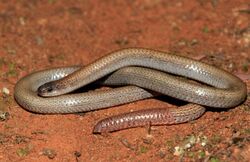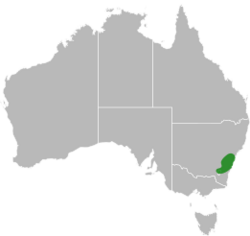Biology:Pink-tailed worm-lizard
| Pink-tailed worm-lizard | |
|---|---|

| |
| Scientific classification | |
| Domain: | Eukaryota |
| Kingdom: | Animalia |
| Phylum: | Chordata |
| Class: | Reptilia |
| Order: | Squamata |
| Family: | Pygopodidae |
| Genus: | Aprasia |
| Species: | A. parapulchella
|
| Binomial name | |
| Aprasia parapulchella Kluge, 1974
| |

| |
The pink-tailed worm-lizard or granite worm-lizard (Aprasia parapulchella) is a rare legless lizard found in Australia. The animal looks like a combination of small snake and worm. Its total length is up to 14 cm. It has a pink tail and is white underneath. The head and neck are brown, and the rest of the top of the body is pale grey. Scales on the back each have a dark bar, giving the appearance of dots down the back.[2] It is found on two hills near Tarcutta, Bathurst, New South Wales, Bendigo in Victoria, and along the sides of the Molonglo River and Murrumbidgee River and on Mount Taylor in the Australian Capital Territory.[3] The lizards eat invertebrates that live under rocks. They can be found under rocks sized from 0.15 to 0.6 m.[4] Their main diet is ant eggs, particularly from Iridomyrmex species and Rhytidoponera metallica.[5]
Genetics
Aprasia parapulchella cells have 42 chromosomes in the diploid state. Males of the species have a heteromorphic pair of chromosomes (a pair of two different ones), termed XY, and the females have a pair of same XX chromosomes. The microsatellite (AGAT)8 is strongly repeated near the Y chromosome centromere. The Y chromosome also contains the (AC)15 motif, whereas the X chromosome does not. (AC)15 also shows up on another two pairs of small and large chromosomes.[6]
Anatomy
The head and tail are both rounded in shape. It differs from a snake in that scaly hind limb flaps are present. Also, its tongue is not forked, but is flat and long. There are no ears visible.[7]
Species-specific characteristics include absence of pattern on the side of the head, two preocular scales and three preanal scales are present, and the first upper labial scale and nasal scale are fused.[2]
Weights of the lizards can range from 0.1 to 4.0 g. At 1 year old, they are around 6 cm from snout to vent, in the second year they reach 8 cm, and in the third year 9.6 cm. Adult males over 3 years old average 10.9 cm and females are slightly bigger at 12 cm.[8]
Threats
The lizard is threatened by habitat fragmentation, removal of rock, grazing, tree planting, weeds, and ploughing.[3] [2]
References
- ↑ Shea, G., Cogger, H. & Greenlees, M. 2018. Aprasia parapulchella. The IUCN Red List of Threatened Species 2018: e.T102827944A102827965. https://doi.org/10.2305/IUCN.UK.2018-1.RLTS.T102827944A102827965.en. Downloaded on 4 April 2019.
- ↑ 2.0 2.1 2.2 "Aprasia parapulchella — Pink-tailed Worm-lizard, Pink-tailed Legless Lizard". Species Profile and Threats Database. Canberra: Department of the Environment. http://www.environment.gov.au/cgi-bin/sprat/public/publicspecies.pl?taxon_id=1665.
- ↑ 3.0 3.1 "Factsheet - Aprasia parapulchella". http://heritage.anu.edu.au/Factsheets/Aprasia_parapulchella.htm.
- ↑ "Bendigo, Flora and Fauna Pink Tailed Worm Lizard". http://www.bendigo.ws/Attractions/Flora-and-Fauna/Pink-Tailed-Worm-Lizard.html.
- ↑ Georges, Arthur (22 December 1997). "The Role of Ant Communities in the Ecology of the Endangered Legless Lizard Aprasia parapulchella: An Interim Report". http://aerg.canberra.edu.au/reprints/1998_Georges_Jones_Robinson_ACTEW_Aprasia.pdf.
- ↑ Matsubara, Kazumi; Theresa Knopp; Stephen D Sarre; Arthur Georges; Tariq Ezaz (2013). "Karyotypic analysis and FISH mapping of microsatellite motifs reveal highly differentiated XX/XY sex chromosomes in the pink-tailed worm-lizard (Aprasia parapulchella, Pygopodidae, Squamata)". Molecular Cytogenetics 6 (1): 60. doi:10.1186/1755-8166-6-60. ISSN 1755-8166. PMID 24344753.
- ↑ "Aprasia parapulchella: Pink-tailed Legless Lizard". Atlas of Living Australia. http://bie.ala.org.au/species/urn:lsid:biodiversity.org.au:afd.taxon:68dd2e4a-6f5e-4b02-afe5-23fb0700500d.
- ↑ David Thye Yau Wong (May 2013). "Environmental factors affecting the occurrence and abundance of the Pink-tailed Worm-lizard (Aprasia parapulchella) in the Australian Capital Territory". http://www.canberra.edu.au/researchrepository/file/a1ebc167-abe6-7ac4-7be6-b85ee31e33f7/1/full_text.pdf.
Further reading
- Wong, D.T.Y.; S.R. Jones; W.S. Osborne; G.W. Brown; P. Robertson; D.R. Michael; G.M. Kay (2011). "The life history and ecology of the Pink-tailed Worm-lizard Aprasia parapulchella Kluge - a review". Australian Zoologist 35 (4): 927–940. doi:10.7882/az.2011.045.
Wikidata ☰ Q6451732 entry
 |






